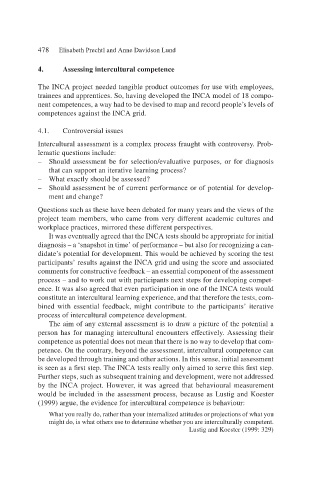Page 500 - Handbooks of Applied Linguistics Communication Competence Language and Communication Problems Practical Solutions
P. 500
478 Elisabeth Prechtl and Anne Davidson Lund
4. Assessing intercultural competence
The INCA project needed tangible product outcomes for use with employees,
trainees and apprentices. So, having developed the INCA model of 18 compo-
nent competences, a way had to be devised to map and record people’s levels of
competences against the INCA grid.
4.1. Controversial issues
Intercultural assessment is a complex process fraught with controversy. Prob-
lematic questions include:
– Should assessment be for selection/evaluative purposes, or for diagnosis
that can support an iterative learning process?
– What exactly should be assessed?
– Should assessment be of current performance or of potential for develop-
ment and change?
Questions such as these have been debated for many years and the views of the
project team members, who came from very different academic cultures and
workplace practices, mirrored these different perspectives.
It was eventually agreed that the INCA tests should be appropriate for initial
diagnosis – a ‘snapshot in time’ of performance – but also for recognizing a can-
didate’s potential for development. This would be achieved by scoring the test
participants’ results against the INCA grid and using the score and associated
comments for constructive feedback – an essential component of the assessment
process – and to work out with participants next steps for developing compet-
ence. It was also agreed that even participation in one of the INCA tests would
constitute an intercultural learning experience, and that therefore the tests, com-
bined with essential feedback, might contribute to the participants’ iterative
process of intercultural competence development.
The aim of any external assessment is to draw a picture of the potential a
person has for managing intercultural encounters effectively. Assessing their
competence as potential does not mean that there is no way to develop that com-
petence. On the contrary, beyond the assessment, intercultural competence can
be developed through training and other actions. In this sense, initial assessment
is seen as a first step. The INCA tests really only aimed to serve this first step.
Further steps, such as subsequent training and development, were not addressed
by the INCA project. However, it was agreed that behavioural measurement
would be included in the assessment process, because as Lustig and Koester
(1999) argue, the evidence for intercultural competence is behaviour:
What you really do, rather than your internalized attitudes or projections of what you
might do, is what others use to determine whether you are interculturally competent.
Lustig and Koester (1999: 329)

